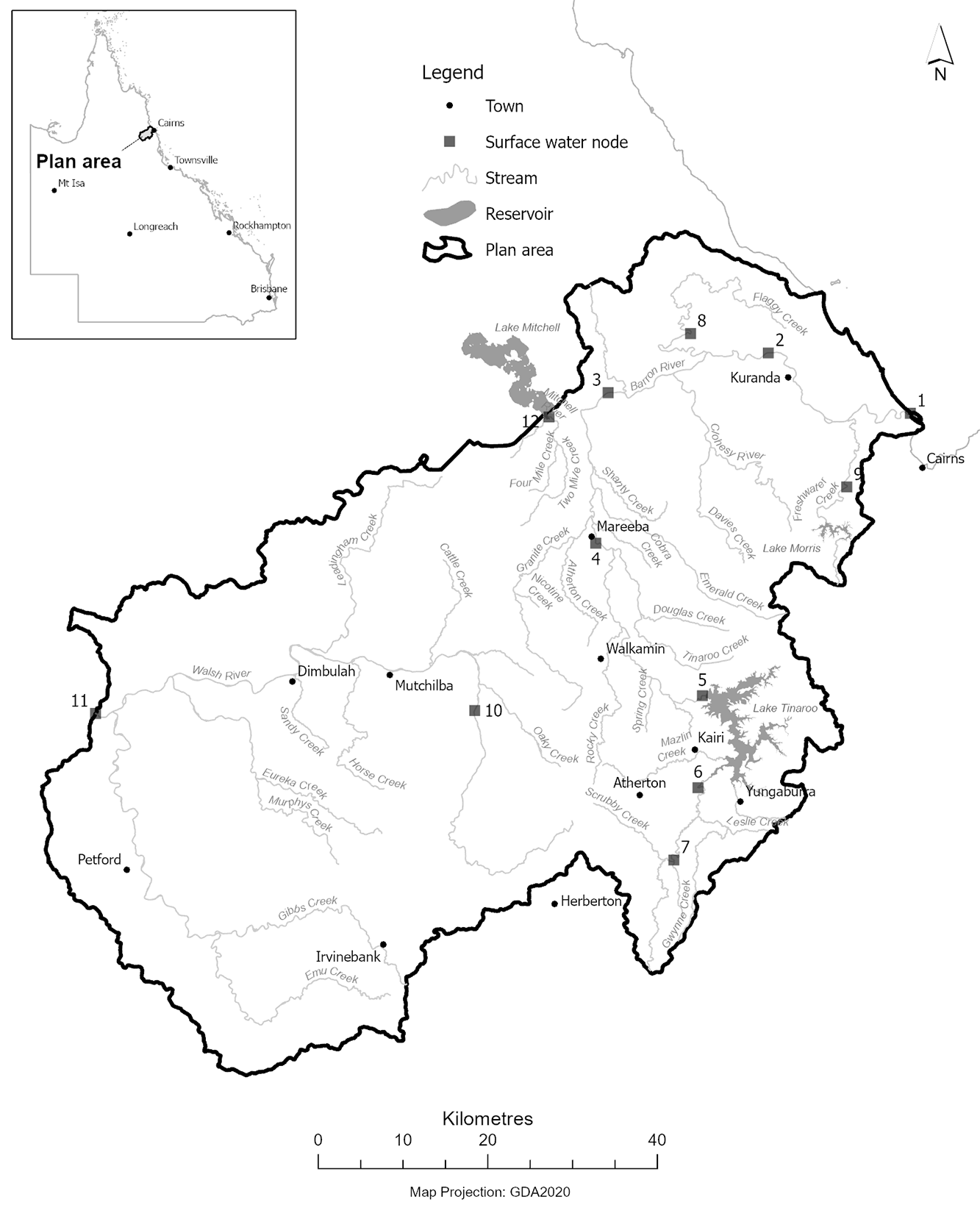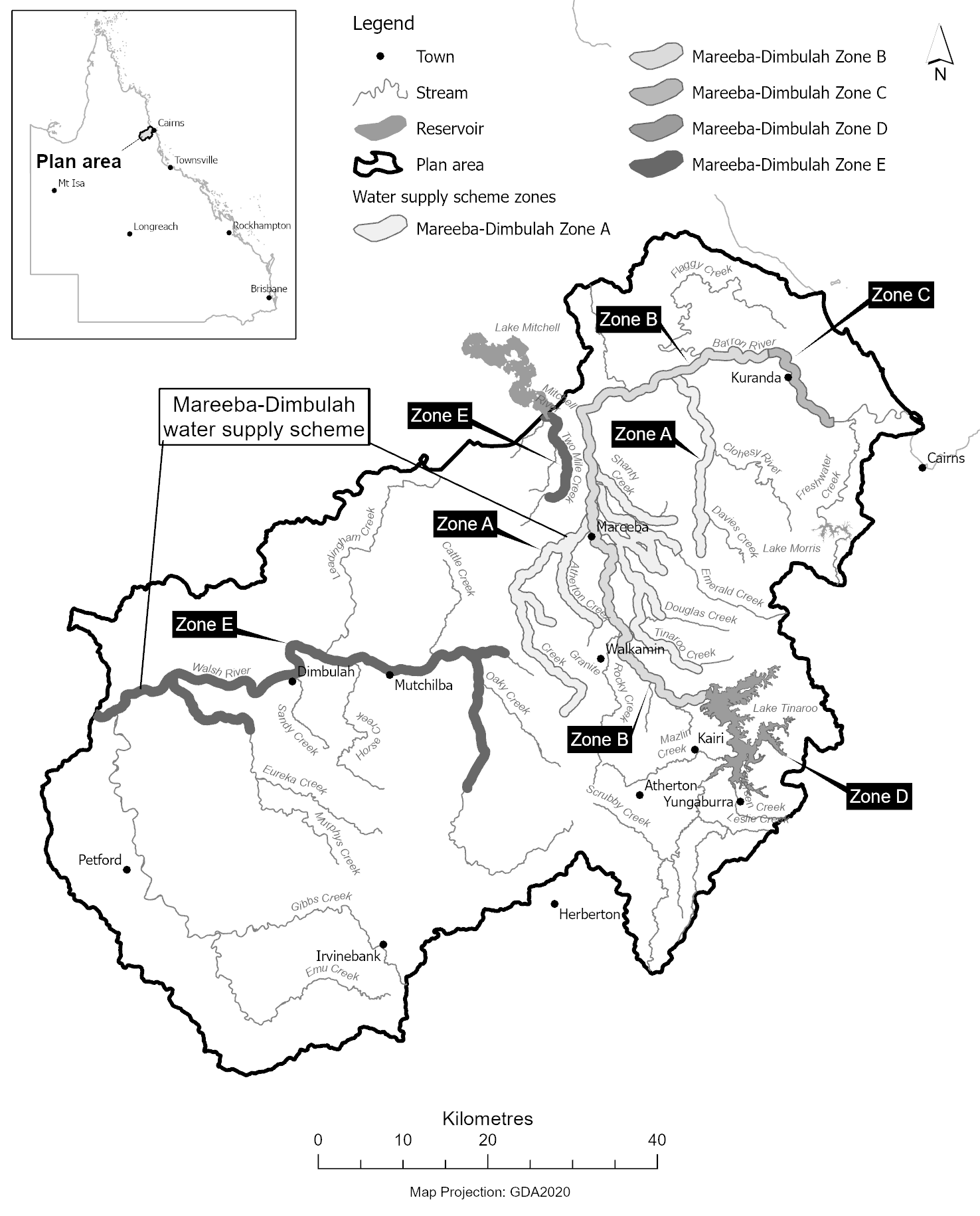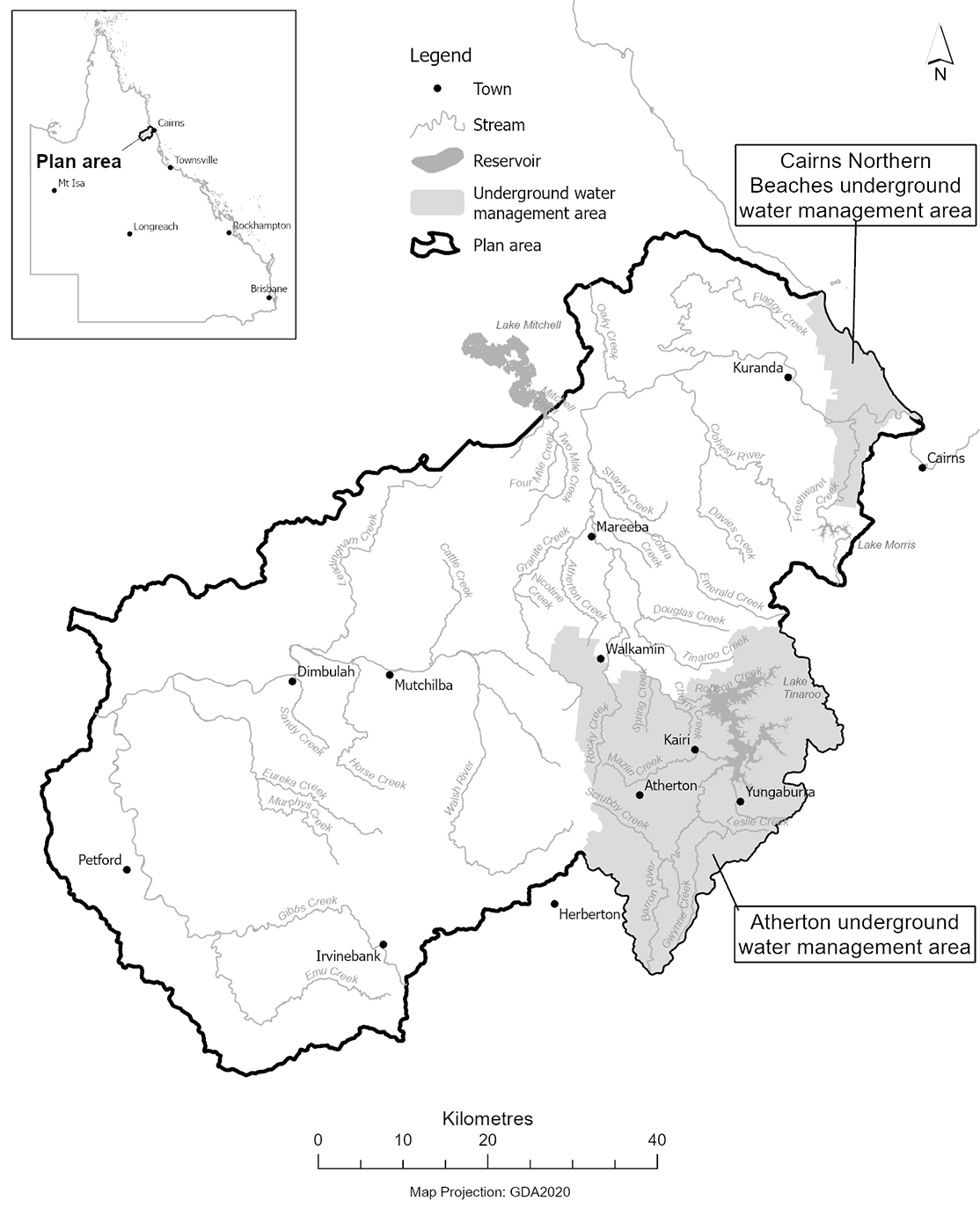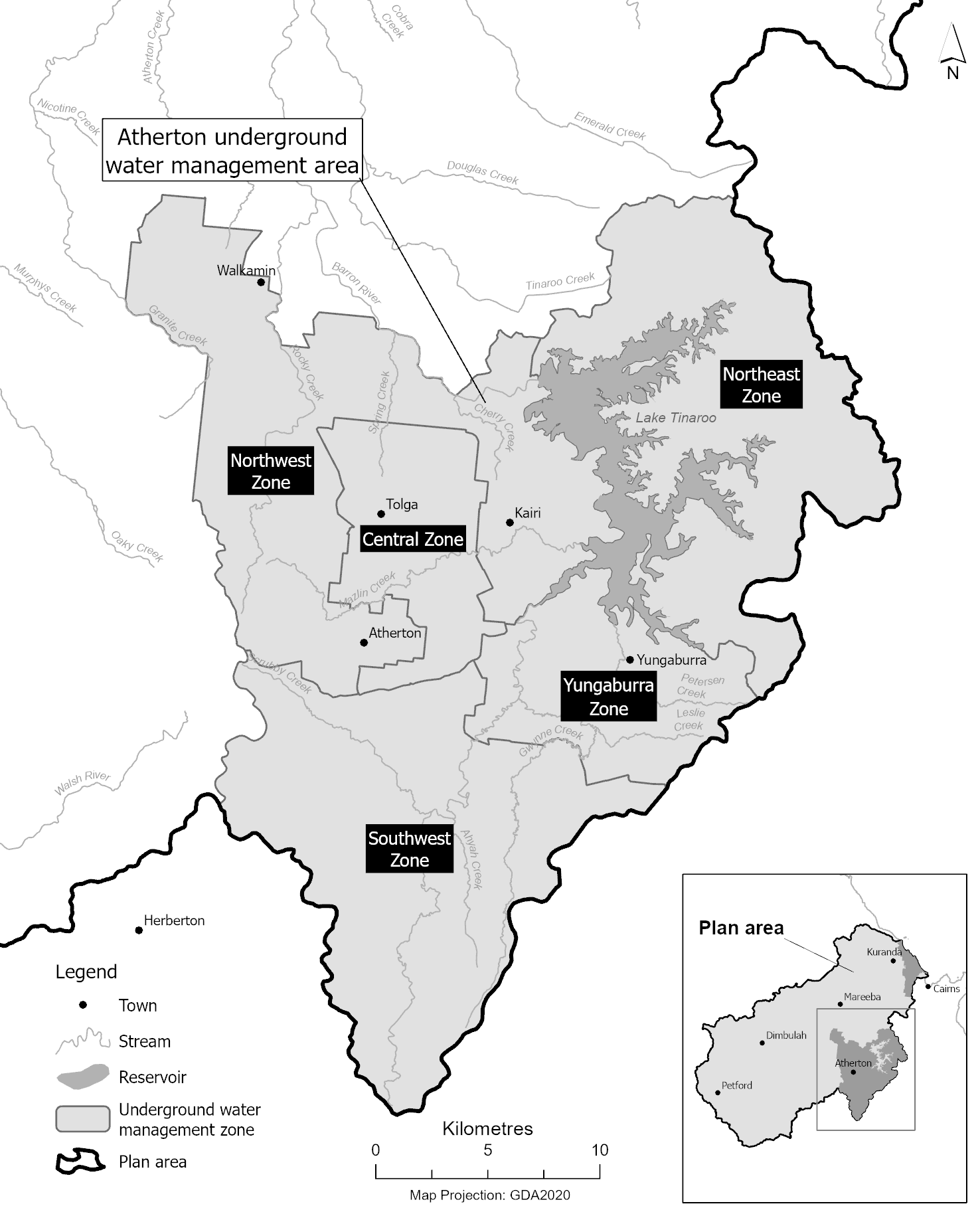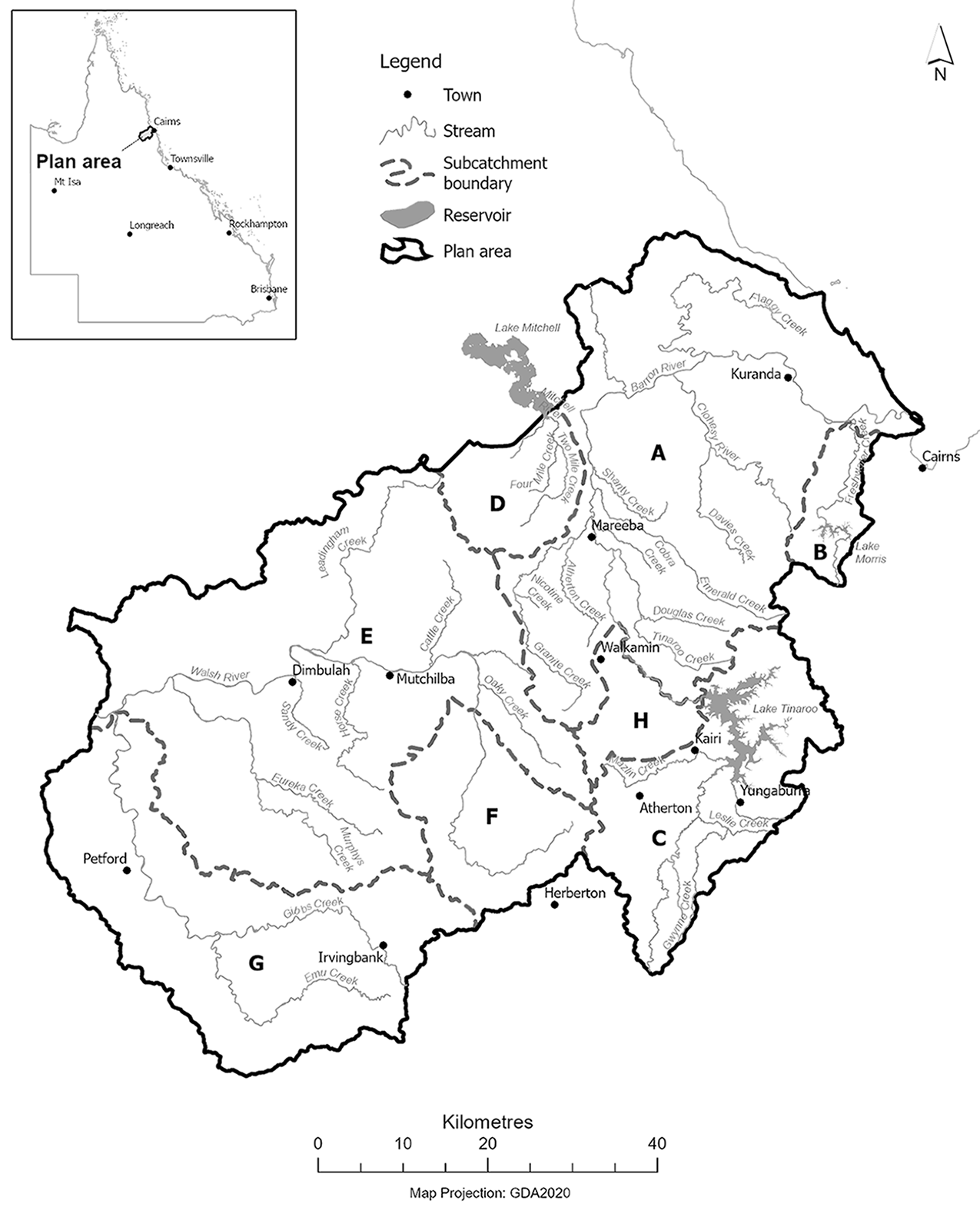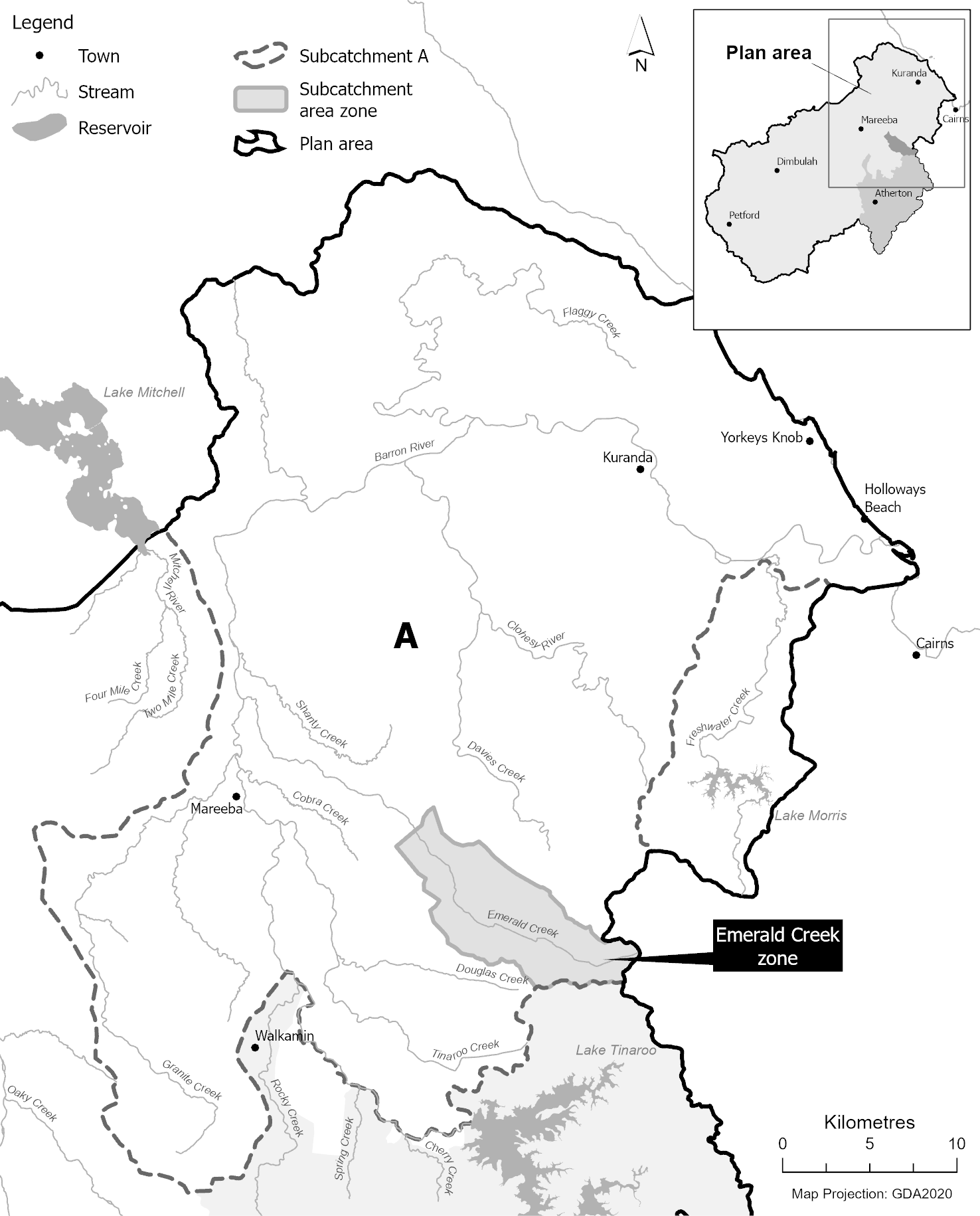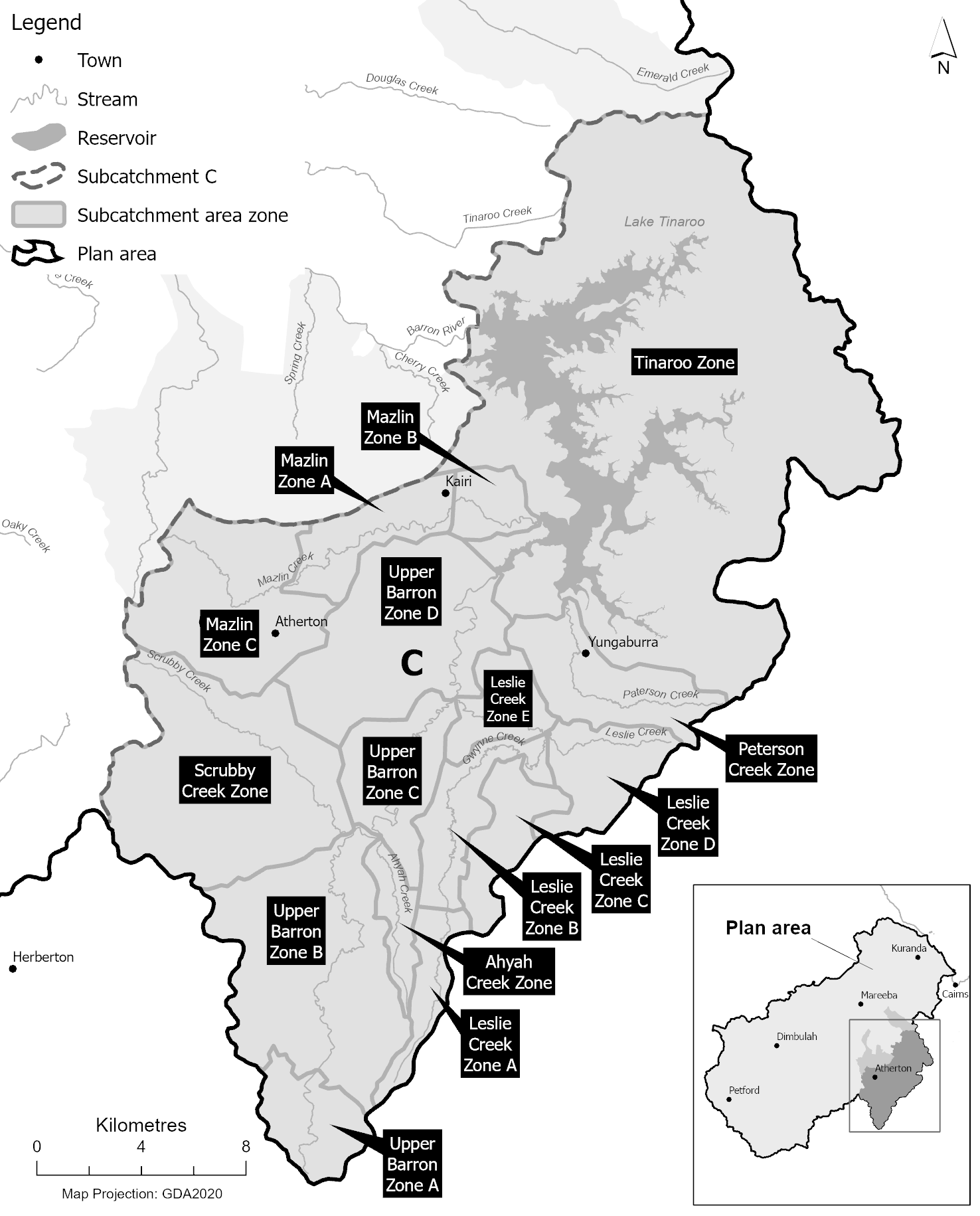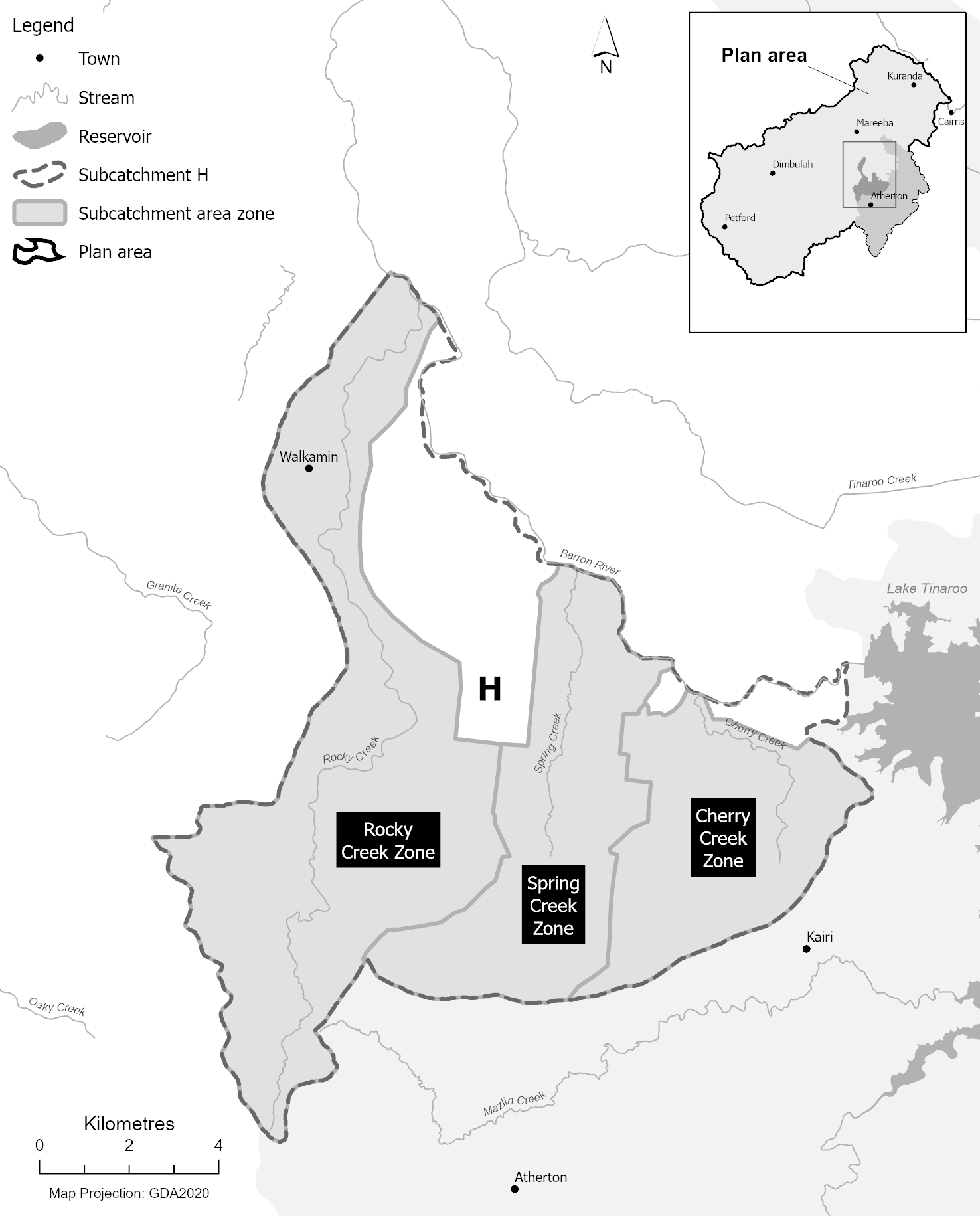This plan may be cited as the Water Plan (Barron) 2023.
The purposes of this plan are to—(a)define the availability of water to which this plan applies; and(b)provide a framework for sustainably managing water to which this plan applies; and(c)identify priorities and mechanisms for dealing with future water requirements in the plan area; and(d)regulate the taking of, and interference with, surface water, and the taking of underground water, to which this plan applies; and(e)provide a framework for establishing and managing water allocations; and(f)provide access to water resources to help Aboriginal people and Torres Strait Islanders achieve their economic, social and cultural aspirations; and(g)provide a framework for reversing, where practicable, the degradation of natural ecosystems caused by the taking of, or interference with, water to which this plan applies.
The dictionary in schedule 7 defines particular words used in this plan.
Surface water is water in a watercourse, lake or spring.
5Water to which plan applies—Act, s 43
For section 43(1)(a) of the Act, this plan applies to the following water in the plan area—(a)surface water;(b)underground water.
This plan applies to the area shown as the plan area on the map in schedule 1, part 1.
7Water supply scheme and water supply scheme zones
(1)The part of the plan area shown as the Mareeba-Dimbulah water supply scheme on the map in schedule 2 is a water supply scheme for this plan.(2)Each part of the plan area shown as a water supply scheme zone on the map in schedule 2 is a water supply scheme zone for this plan.
8Water management area—Act, sch 4
For schedule 4 of the Act, definition water management area, paragraph (b), the plan area is a water management area called the Barron Water Management Area.
9Underground water management areas
(1)Each part of the plan area shown as an underground water management area on the map in schedule 3, part 1 is an underground water management area for this plan.(2)A reference in this plan to an underground water management area by name is a reference to the underground water management area given that name on the map in schedule 3, part 1.
10Underground water management area zones
(1)The Atherton Underground Water Management Area is divided into underground water management area zones.(2)A part of the Atherton Underground Water Management Area shown on the map in schedule 3, part 2 as an underground water management area zone is an underground water management area zone.(3)A reference in this plan to an underground water management area zone by name is a reference to the underground water management area zone given that name in schedule 3, part 2.
(1)Each part of the plan area that is within a subcatchment area shown on the map in schedule 4, part 1 is a subcatchment area for this plan.(2)A reference in this plan to a subcatchment area by name is a reference to the subcatchment area given that name on the map in schedule 4, part 1.
(1)Certain subcatchment areas have 1 or more subcatchment area zones.(2)A subcatchment area zone, for a subcatchment area, is—(a)for subcatchment area A—shown on the map in schedule 4, part 2; and(b)for subcatchment area C—shown on the map in schedule 4, part 3; and(c)for subcatchment area H—shown on the map in schedule 4, part 4.
For section 43(1)(e)(i) of the Act, the following zones are trading zones for water allocations and water licences to which this plan applies—(a)a water supply scheme zone;(b)a subcatchment area zone for subcatchment area A, C or H.
(1)A node mentioned in this plan is a place—(a)on a watercourse in the plan area; and(b)for which environmental flow objectives are set for performance indicators.(2)The location of each node is shown on the map in schedule 1, part 1 and described in schedule 1, part 2.(3)Each node is identified on the map by a number.
The exact location of the boundaries of each of the following is held in digital electronic form by the department and may be accessed at each office of the department—(a)the plan area;(b)a water supply scheme;(c)a water supply scheme zone;(d)the water management area;(e)an underground water management area;(f)an underground water management area zone;(g)a subcatchment area;(h)a subcatchment area zone for subcatchment area A, C or H.The location of each office of the department is available on the department’s website.
This part states, for section 43(1)(b) of the Act, the water plan outcomes for this plan.
A water plan outcome for this plan is that water to which this plan applies is to be allocated and managed in a way that—(a)recognises that the natural state of watercourses, lakes, springs and aquifers has changed because of the taking of, or interference with, water; and(b)seeks to achieve a balance between—(i)the economic water plan outcomes stated in section 18; and(ii)the social water plan outcomes stated in section 19; and(iii)the cultural water plan outcomes stated in section 20; and(iv)the environmental water plan outcomes stated in section 21; and(c)promotes improved understanding of—(i)matters affecting the flow-related, and underground water dependent, health of ecosystems, including springs, in the plan area; and(ii)the flow requirements of ecosystems in the plan area; and(iii)the water required for social, spiritual and cultural uses by Aboriginal people and Torres Strait Islanders; and(iv)the water required to deliver social and economic benefits to communities in the plan area; and(v)the impact of climate change on water availability.
18Water plan outcomes—economic
The economic water plan outcomes for this plan are—(a)to provide for the continued use of all water entitlements and other authorisations to take or interfere with water; and(b)to maintain the probability of being able to take water to which this plan applies under a water entitlement; and(c)to maintain the availability of water to which this plan applies for industries dependent on water resources in the plan area, including, for example—(i)agriculture; and(ii)hydro-electric power generation; and(iii)tourism; and(iv)aquaculture; and(d)to provide for mechanisms that support water being made available for growth in industries dependent on water resources in the plan area; and(e)to make water to which this plan applies available to support the economic aspirations of Aboriginal people and Torres Strait Islanders; and(f)to improve and support the effective and efficient operation of the market in water allocations and relocatable water licences.
The social water plan outcomes for this plan are—(a)to maintain—(i)the availability of water to which this plan applies for the supply of urban water to towns and communities dependent on the water resources of the plan area; and(ii)the flows of water to which this plan applies to significant areas that support water-related aesthetic and recreational values, including the Barron Falls, Barron Gorge and Tinaroo Falls Dam; and(b)to provide water to which this plan applies—(i)for domestic purposes in the plan area; and(ii)to meet increased demand for urban water supply for the Cairns local government area from Lake Placid; and(c)to make water to which this plan applies available to support the social aspirations of Aboriginal people and Torres Strait Islanders.
20Water plan outcomes—cultural
The cultural water plan outcomes for this plan are—(a)to make water to which this plan applies available to support the cultural aspirations of Aboriginal people and Torres Strait Islanders; and(b)to maintain the flows of water to which this plan applies that support the water-related cultural, spiritual and social values of Aboriginal people and Torres Strait Islanders; and(c)to recognise and respect the cultural and spiritual connection to water of Aboriginal people and Torres Strait Islanders through—(i)engaging Aboriginal people and Torres Strait Islanders in the processes for making decisions about the future management and allocation of water in the plan area; and(ii)integrating knowledge about Aboriginal tradition, Island custom and science into the processes for making decisions about the future management and allocation of water in the plan area; and(d)to manage and allocate water in Flaggy Creek in a way that protects areas of significant cultural conservation value associated with the creek.
21Water plan outcomes—environmental
(1)The environmental water plan outcomes for this plan are—(a)to maintain and if possible improve flows of water to which this plan applies that support—(i)native plants and animals and their associated freshwater habitats; and(ii)riparian systems and their functions; and(iii)long-term water quality suitable for riverine and estuarine ecosystems; and(iv)river forming processes; and(v)ecosystem food chains and the provision of carbon energy; and(vi)the health and persistence of waterholes in subcatchment areas E, F and G; and(b)to maintain and if possible improve flows of water to which this plan applies that support the continued capability of 1 part of a river system to be connected to another—(i)throughout the watercourse network; and(ii)within riparian zones, floodplains and associated freshwater habitats; and(c)to maintain and if possible improve flows of water to which this plan applies that support freshwater flows to the estuary in the plan area in order to—(i)provide freshwater flow from the plan area to marine waters of the Great Barrier Reef; and(ii)deliver sediment, nutrients and organic matter that support productivity in the waters of the Great Barrier Reef that receive flows of water from the plan area; and(iii)maintain brackish water estuarine habitat; and(iv)benefit native estuarine plants and animals; and(d)the management and allocation of underground water in the plan area to maintain underground water contributions to—(i)the flow of water in watercourses, lakes and springs; and(ii)groundwater dependent ecosystems, including wetlands, springs and terrestrial vegetation communities.(2)In this section—waterhole means a part of a watercourse that contains water after the watercourse ceases to flow, other than a part of a watercourse that is within the storage area of a dam on the watercourse.
22General measure that contributes to achieving water plan outcomes
A measure that contributes to achieving the water plan outcomes stated in part 3 is that a monitoring, evaluation and reporting strategy, to support assessment of the effectiveness of this plan and its implementation, is developed by the chief executive by 20 December 2023.
23Environmental flow objectives and performance indicators—Act, s 43
(1)For section 43(1)(d) of the Act, the environmental flow objectives for surface water to which this plan applies are stated in schedule 5.(2)The performance indicators for the environmental flow objectives are stated in schedule 5.
24Water allocation security objectives and performance indicators—Act, s 43
(1)For section 43(1)(e)(ii) of the Act, the water allocation security objectives for a decision made by the chief executive under chapter 2 of the Act, for surface water to which this plan applies, are that—(a)the performance ratio, for each group of water allocations to take supplemented water that state they are in the ‘high priority group’ or the ‘medium priority group’, is not less than 99% of what the performance ratio for the group was immediately before the commencement; and(b)the performance ratio for each group of water allocations to take unsupplemented water is not less than—(i)98% of what the performance ratio for the group was immediately before the decision is made; and(ii)92% of what the performance ratio for the group was immediately before the commencement.(2)The performance indicators for the water allocation security objectives mentioned in subsection (1) are the performance ratios for each group of water allocations mentioned in subsection (1)(a) and (b).(3)In this section—performance ratio, for a group of water allocations, means the average annual volume of water that may be taken by holders of all water allocations in the group in the simulation period expressed as a percentage of the total of the nominal volume for all water allocations in the group.
25Calculation of performance indicators
A performance indicator mentioned in section 23 or 24 must be calculated on the assumption that unallocated water reserved under this plan is being taken.See section 31 for unallocated water reserved under this plan.
This part applies to surface water and underground water in the plan area.
27Limitations on taking water for particular activities—Act, s 101
For section 101(1) of the Act, the total volume of water to which this plan applies that may be taken by a person during a water year for activities prescribed under section 101(1)(a) of the Act is—(a)for water taken from part of a watercourse used for distribution of water by a resource operations licence holder—0ML; and(b)for water taken in subcatchment area C or H—20ML.1The part of the plan area included in subcatchment areas C and H is the same part included in the Atherton underground water management area.2The 20ML of water that may be taken under paragraph (b) includes surface water and underground water.
28Limitations on taking underground water in underground water management areas—Act, s 101
For section 101(1) of the Act, a person must not, under section 101(1)(c) of the Act, take underground water in the Atherton underground water management area or the Cairns Northern Beaches underground water management area unless the water is taken—(a)under a water licence or water permit; or(b)for stock or domestic purposes; or(c)for underground water in the Atherton underground water management area—in accordance with section 27(b).
29Taking water for stock or domestic purposes—Act, s 103
For section 103(a) of the Act—(a)the location stated is a watercourse (other than a part of a watercourse used for distribution of water by a holder of a resource operations licence), lake or spring in the plan area; and(b)the way stated is any way.
This part applies to surface water in the plan area.
31Unallocated water reserved under this plan—Act, s 43
(1)For section 43(1)(c) of the Act, the total volume reserved is 24,850ML.(2)For section 43(2)(e) of the Act—(a)the volume reserved for water entitlements to take unallocated water in the plan area for a general purpose is 1,250ML, plus any additional volume of unallocated water stated in the water management protocol for this plan as being reserved for a general purpose; and(b)the volume reserved for water entitlements to take unallocated water in the plan area for an Indigenous purpose is 2,600ML, plus any additional volume of unallocated water stated in the water management protocol for this plan as being reserved for an Indigenous purpose; and(c)the volume reserved for water licences to take unallocated water in the plan area for a strategic purpose is 4,000ML.
32Purpose for which unallocated water may be granted
Unallocated water in the plan area may be granted only for the following purposes—(a)for unallocated water held as a general reserve—any purpose;(b)for unallocated water held as a strategic reserve—town water supply;(c)for unallocated water held as an Indigenous reserve—an Indigenous purpose.
33Processes for releasing unallocated water—Act, s 43
(1)For section 43(2)(f) of the Act, this section states the process for releasing unallocated water reserved under this plan.(2)The process for granting unallocated water under a strategic reserve is the process stated in the Water Regulation 2016, part 2, division 2, subdivision 2.(3)The process for granting unallocated water under an Indigenous reserve is a process stated in the water management protocol for this plan.
34Matters chief executive must consider
(1)In implementing a process for dealing with unallocated water under a general reserve or strategic reserve, the chief executive must consider—(a)the efficiency of existing and proposed water use practices; and(b)the availability of an alternative water supply for the purpose for which the water is required; and(c)the impact the proposed taking of, or interfering with, the water may have on the following—(i)water quality;(ii)inundation of habitats;(iii)the movement of fish and other aquatic species;(iv)the natural movement of sediment;(v)recreation and aesthetic values;(vi)cultural values, including, for example, cultural values of local Aboriginal or Torres Strait Islander communities; and(d)whether the proposed taking or interfering is likely to have a direct adverse effect on underground water flows.(2)Subsection (1) does not limit the matters the chief executive may consider.
35Decisions consistent with objectives
A decision made by the chief executive under chapter 2 of the Act about the allocation or management of water to which this plan applies, other than a decision about a water permit, must be consistent with—(a)the environmental flow objectives stated in section 23; and(b)the water allocation security objectives stated in section 24.
36Assessing impact of decisions
(1)The eWater Source computer program’s simulation for the simulation period is used to assess consistency with the objectives mentioned in section 35.(2)If it is not practicable to use the eWater Source computer program, another assessment method approved by the chief executive may be used.(3)The chief executive may approve an assessment method for subsection (2) only if the chief executive is satisfied the method will assess consistency with the objectives at least as accurately as the eWater Source computer program.(4)In this section—eWater Source computer program means the computer program used by the department to simulate daily stream flows, flow management, storages, releases, in-stream infrastructure, water diversions, water demands and other hydrological events in the plan area.
This division states, for section 43(2)(g) of the Act, arrangements and processes for converting, under a water entitlement notice for this plan, particular authorisations to water allocations to take unsupplemented surface water to which this plan applies.
In this division—existing authorisation means a water licence to take unsupplemented surface water from a watercourse, lake or spring in the plan area.
39Existing authorisation may be converted to water allocation
A water entitlement notice may, under section 70(1)(a) of the Act, implement this plan by providing for the conversion of an existing authorisation to a water allocation stated in the notice to take unsupplemented surface water from a watercourse, lake or spring in the plan area.
40Elements of water allocation
The water allocation must state the following—(a)the nominal volume for the allocation;(b)the annual volumetric limit for the allocation;(c)the daily volumetric limit for the allocation;(d)the flow conditions under which water may be taken;(e)the purpose of the allocation.
(1)In deciding the nominal volume for the water allocation, the chief executive must have regard to—(a)the local availability of water; and(b)the conditions under which the water may be taken under the existing authorisation; and(c)the simulated mean annual diversion.(2)In this section—simulated mean annual diversion, for a water allocation, means the total volume of water simulated to have been taken under the water allocation, if the water allocation were in existence for the whole of the simulation period, divided by the number of years in the simulation period.
The annual volumetric limit for the water allocation is—(a)for an existing authorisation that states an annual volume of water—the stated volume; or(b)for an existing authorisation that states an area that may be irrigated—the volume, expressed in megalitres, calculated by multiplying the area, in hectares, by 10; or(c)for another existing authorisation—the volume decided by the chief executive having regard to—(i)the conditions under which water may be taken under the authorisation; and(ii)the water taking capacity of any existing works for taking water under the authorisation; and(iii)the annual volumes of water estimated by the chief executive to have been taken under the existing authorisation during the period, of not more than 10 years, immediately before 20 December 2002; and(iv)the efficiency of the use of the water mentioned in subparagraph (iii).
(1)The daily volumetric limit for the water allocation is—(a)for an existing authorisation that states the volume of water that may be taken in a day—the stated volume; or(b)for another existing authorisation—the daily volumetric limit decided by the chief executive having regard to—(i)the type of authorisation; and(ii)an estimate or measurement of the rate at which water can be taken under the authorisation.(2)However, for subsection (1)(b), if the holder of the existing authorisation satisfies the chief executive that the water taking capacity of an existing pump is different from the daily volumetric limit decided under the subsection, the daily volumetric limit is the volume decided by the chief executive having regard to the following—(a)the conditions under which the water may be taken under the authorisation;(b)the water taking capacity of the existing pump under normal operating conditions;(c)the irrigation or water distribution system related to the existing pump during the period of not more than 10 years immediately before 27 November 2009;(d)the efficiency of the water use associated with the irrigation or water distribution system mentioned in paragraph (c).(3)In this section—existing pump, in relation to an existing authorisation, means a pump used under—(a)the existing authorisation; or(b)a development permit for the existing authorisation.
In deciding the conditions under which water may be taken under the water allocation, the chief executive must have regard to the conditions stated on the existing authorisation.
The purpose stated on the water allocation must be—(a)if the purpose stated on the existing authorisation is stock, domestic, irrigation, stock intensive, agriculture, dairy, water harvesting, aquaculture or a similar purpose—‘rural’; or(b)if the purpose stated on the existing authorisation is distribution loss—‘distribution loss’; or(c)otherwise—‘any’.
46Water allocation groups—Act, sch 4
For schedule 4 of the Act, definition water allocation group—(a)a water allocation to take unsupplemented water in subcatchment area C belongs to—(i)for a water allocation in relation to town water supply—the class CA water allocation group; and(ii)for a water allocation that states a purpose or similar purpose mentioned in section 45(a), other than water harvesting, or a purpose mentioned in section 45(c)—the class CB water allocation group; and(iii)for other water allocations—the class CC water allocation group; and(b)a water allocation to take unsupplemented water in subcatchment area H belongs to the class HB water allocation group.
47Applications for water licences that must not be accepted
For section 43(2)(j) of the Act, the chief executive must not accept an application for a water licence made under section 107 of the Act unless it is an application—(a)to which subdivision 2 applies; or(b)for a water licence that states the purpose of ‘hydro-electric’ or ‘relift’.
48Particular applications for dealings with water licences inconsistent with this plan
(1)The granting of an application made under section 121 of the Act for a dealing with a water licence in relation to water to which this plan applies is inconsistent with this plan if, under section 130 of the Act, the application must be assessed as if it were an application for a new water licence.See section 129 of the Act for the actions the chief executive must take if the granting of an application for a dealing with a water licence is inconsistent with a water plan.(2)However, subsection (1) does not apply to the application if—(a)the application is to change the daily volumetric limit of the water licence; and(b)the change will not result in a volume that is greater than the daily volumetric limit stated in schedule 6, having regard to the pump size stated on the related development permit for the licence; and(c)the chief executive is satisfied that the change will not have a significant adverse effect on the availability of water for existing water holders in the subcatchment area in which the water is taken.(3)In this section—related development permit, for a water licence, means the development permit for the works for taking water under the licence.
This subdivision applies to an application, made under section 107 of the Act, for a water licence to interfere with water in a watercourse, lake or spring in the plan area.
50Matters for deciding applications
In deciding the application, the chief executive must consider the impact the proposed interference with water in the watercourse, lake or spring may have on—(a)in-stream water levels in the watercourse, lake or spring; and(b)the natural movement of sediment; and(c)the bed and banks of the watercourse, lake or spring; and(d)riparian vegetation; and(e)habitats for native plants and animals; and(f)the movement of fish and other aquatic species; and(g)the cultural and environmental values of the watercourse, lake or spring.
51Limitations on interference with water
The water licence may be granted only if the purpose of the proposed interference is a purpose provided for in this subdivision.
52Interference with water to enable taking of water for stock or domestic purposes
(1)This section applies if the purpose of the proposed interference with water is to store water to be taken for stock or domestic purposes.(2)The storage capacity of the proposed interference must not be greater than—(a)for a water licence to interfere with water in subcatchment area A, B, C or H—20ML; or(b)for other water licences—200ML.
53Interference with water for provision of pumping pool
(1)This section applies if the purpose of the proposed interference with water is to provide a pumping pool to enable water to be taken under an authorisation.(2)The storage capacity of the pumping pool must not be greater than 2ML.(3)In this section—pumping pool means a pool of water near a pump in a watercourse, lake or spring that ensures the water level of the watercourse, lake or spring is appropriate to enable the pump to function properly.
54Interference with water to improve security for town water supply
(1)This section applies if the purpose of the proposed interference with water is to provide improved security for town water supplies taken under an authorisation.(2)The chief executive must not grant the application unless the chief executive is satisfied—(a)the town has appropriate water supply security strategies, such as demand and drought management strategies, in place; and(b)there is a demonstrated need for improved security of the water supply.
55Interference with water to store water or divert water for purpose not related to the taking of water under water entitlement
(1)This section applies if the purpose of the proposed interference with water is to store water or divert water for a purpose not related to the taking of water under a water entitlement.Examples of a purpose for subsection (1)—
community landscaping, retention of water for flood mitigation purposes, storing water for a micro-hydroelectric power scheme, diverting a watercourse for construction of a railway or mining site(2)The interference must not be greater than the volume necessary for the purpose of the interference.
56Interference with water related to the granting of unallocated water
(1)This section applies if the purpose of the proposed interference with water is related to the releasing of unallocated water under the process mentioned in section 33.(2)The interference must not be greater than is necessary for the purpose of taking the unallocated water.
(1)A water licence to take unsupplemented water must state each of the following—(a)the purpose for which water may be taken under the licence;(b)the nominal entitlement for the licence;(c)the daily volumetric limit for the licence;(d)if a condition applies to the licence, including, for example, a flow condition under which water may be taken or a condition about storing water taken under the licence—the condition.(2)However—(a)subsection (1)(b) does not apply to a licence that states a purpose of ‘hydro-electric’ or ‘relift’; and(b)subsection (1)(c) does not apply to a licence that states a purpose of ‘relift’.
58Purpose to be stated on water licence
(1)The purpose to be stated on a water licence to take unsupplemented water that replaces an existing licence must be—(a)if the purpose stated on the existing licence is stock or domestic—‘stock and domestic’; or(b)if the purpose stated on the existing licence is irrigation, stock intensive, agriculture, dairy, water harvesting, aquaculture or a similar purpose—‘rural’; or(c)if the purpose stated on the existing licence is relift or a similar purpose—‘relift’; or(d)if the purpose stated on the existing licence is hydro-electric or a similar purpose—‘hydro-electric’; or(e)otherwise—‘any’.(2)The purpose to be stated on a water licence to take unsupplemented water, other than a water licence mentioned in subsection (1), must be—(a)‘stock and domestic’; or(b)‘rural’; or(c)‘relift’; or(d)‘hydro-electric’; or(e)‘Indigenous’; or(f)‘any’.(3)In this section—existing licence means a water licence to take unsupplemented water in effect immediately before 27 November 2009.
(1)Subsection (2) states the nominal entitlement for a water licence to take unsupplemented water.(2)The nominal entitlement is—(a)for a licence that states a volume of water that may be taken—the stated volume; or(b)for a licence that states an area that may be irrigated—the volume decided by the chief executive having regard to the volume of water required to efficiently irrigate the area, but not more than the volume, expressed in megalitres, calculated by multiplying the area, in hectares, by—(i)for subcatchment area B—3; or(ii)for subcatchment area C or H—10; or(iii)for other subcatchment areas—6.6; or(c)for another licence—the volume decided by the chief executive having regard to—(i)the conditions under which water may be taken under the licence; and(ii)the water taking capacity of any existing works for taking water under the licence; and(iii)the annual volumes of water estimated by the chief executive to have been taken under the licence during the period, of not more than 10 years, immediately before 20 December 2002; and(iv)the efficiency of the use of the water mentioned in subparagraph (iii).
The daily volumetric limit to take unsupplemented water under a water licence is the daily volumetric limit mentioned in section 43 or decided by the chief executive under that section as if the water licence were a water allocation.
This part applies to underground water in the plan area.
A water licence to take underground water must state—(a)the purpose for which water may be taken under the licence; and(b)the nominal entitlement for the licence.
63Purpose to be stated on water licence
(1)The purpose to be stated on a water licence to take underground water that replaces an existing licence must be—(a)if the purpose stated on the existing licence is irrigation, stock intensive, agriculture, dairy, water harvesting, aquaculture or a similar purpose—‘rural’; or(b)otherwise—‘any’.(2)The purpose to be stated on a water licence to take underground water, other than a water licence mentioned in subsection (1), must be—(a)‘rural’; or(b)‘any’; or(c)‘town water supply’.(3)In this section—existing licence means a water licence to take underground water in effect immediately before 27 November 2009.
This division applies to water licences to take water in the Atherton underground water management area.
65Applications for water licences that must not be accepted
For section 43(2)(j) of the Act, the chief executive must not accept an application for a water licence under section 107 of the Act.
66Particular applications for dealing with water licences inconsistent with this plan
The granting of an application made under section 121 of the Act for a dealing with a water licence is inconsistent with this plan if, under section 130 of the Act, the application must be assessed as if it were an application for a new water licence.See section 129 of the Act for the actions the chief executive must take if the granting of an application for a dealing with a water licence is inconsistent with a water plan.
67Decisions about taking underground water
(1)This section applies to an application made under section 107 of the Act for a water licence, or an application made under section 121 of the Act for a dealing with a water licence, to take underground water in the Cairns Northern Beaches underground water management area, if granting the application would increase the volume of underground water authorised to be taken.(2)For section 43(2)(h) of the Act, the criteria for deciding the application are—(a)the availability of an alternative water supply for the purpose for which the water is required; and(b)the efficiency of existing and proposed water use practices; and(c)whether the proposed taking is likely to have a direct adverse effect on surface water flows; and(d)the cumulative impact of taking underground water on surface water flows and underground water flows; and(e)existing water entitlements and authorities to take or interfere with water in the Cairns Northern Beaches underground water management area; and(f)any information about the effects of taking, or interfering with, water on natural ecosystems generally, including the impact of seawater intrusion; and(g)any information about the effects of taking, or interfering with, water on the physical integrity of watercourses, lakes, springs or aquifers generally; and(h)any information about the effects of taking, or interfering with, water on cultural values.(3)Subsection (2) does not limit the matters the chief executive may consider.
68Restriction on nominal entitlement
In deciding the nominal entitlement for a water licence to take underground water in the Cairns Northern Beaches underground water management area, the chief executive must not decide a volume that is more than—(a)for a licence to take water for irrigation of a crop—1.75ML for each hectare of crop to be irrigated; or(b)for a licence to take water for another purpose—the volume estimated by the chief executive to be required for the purpose.Examples of another purpose for which water is taken—
irrigation of lawns, parks, sports ovals, pastures
69Water management protocol—Act, ss 43 and 67
(1)For section 43(2)(l) of the Act, a water management protocol must be prepared for the plan area.(2)For section 67 of the Act, the water management protocol must address the following matters for the plan area—(a)the volumes of unallocated water reserved for stated purposes or stated locations;(b)the process for releasing unallocated water held as an Indigenous reserve;(c)the criteria and process for deciding applications for a seasonal water assignment or relocation of a water licence;(d)for water allocations managed under a resource operations licence—the water allocation dealing rules;(e)for water allocations not managed under a resource operations licence—(i)the seasonal water assignment rules; and(ii)the water allocation dealing rules; and(iii)the water sharing rules;(f)the water sharing rules for water licences to take underground water in the Atherton underground water management area;(g)monitoring requirements for water and natural ecosystems in the plan area.
70Amendments to this plan that may be made without consultation—Act, s 43
For section 43(2)(m) of the Act, the following amendments may be made to this plan without public consultation—(a)an amendment or addition of a performance indicator or environmental flow objective if the amendment or addition does not adversely affect—(i)the achievement of the water plan outcomes stated in part 3; or(ii)the water allocation security objectives stated in section 24;(b)an amendment or addition of a water allocation security objective if the amendment or addition does not adversely affect—(i)the achievement of the water plan outcomes stated in part 3; or(ii)the environmental flow objectives stated in section 23;(c)an amendment or addition of a node;(d)an amendment or addition of a priority group mentioned in section 24(1)(a);(e)an amendment or addition of a water allocation group;(f)an amendment to adjust the boundaries of the following areas if more accurate information about the boundaries, or hydrological characteristics, of the plan area becomes available—(i)the plan area;(ii)the water management area;(iii)an underground water management area;(iv)a subcatchment area;(g)an amendment to change the period within which a measure for achieving a stated water plan outcome is to be achieved;(h)an amendment to remove a provision of this plan that no longer has effect.
The Water Plan (Barron) 2002, SL No. 378 is repealed.
In this division—repealed plan means the repealed Water Plan (Barron) 2002.
73Applications for water licences made before commencement
(1)This section applies to an application for a water licence to take or interfere with water to which the repealed plan applied that was made, but not decided, before the commencement.(2)If the chief executive would not, under section 47, be able to accept the application had it been made after the commencement, the application is of no effect and is taken not to have been made.(3)If the chief executive would be permitted, under section 47, to accept the application had it been made after the commencement, the application is to be decided under this plan.
74Applications for dealing with water licences made before commencement
(1)This section applies to an application for a dealing with a water licence to take or interfere with water to which the repealed plan applied if the application was made, but not decided, before the commencement.(2)If the granting of the application would be inconsistent with this plan had the application been made after the commencement, the application is inconsistent with this plan.See section 129 of the Act for the actions the chief executive must take if granting an application for a dealing with a water licence would be inconsistent with a water plan.(3)If the granting of the application would not be inconsistent with this plan had the application been made after the commencement, the application is to be decided under this plan.
sections 6 and 14
Node | Location |
1 | Barron River at river mouth (AMTD 0.0km) |
2 | Barron River at Myola (AMTD 27.1km) |
3 | Barron River at Bilwon (AMTD 49.3km) |
4 | Barron River at Mareeba (AMTD 70.2km) |
5 | Barron River at Tinaroo Falls (AMTD 101.1km) |
6 | Barron River at Picnic Crossing (AMTD 127.0km) |
7 | Barron River at Goonara (AMTD 143.7km) |
8 | Flaggy Creek at recorder (AMTD 13.0km) |
9 | Freshwater Creek at Freshwater (AMTD 14.6km) |
10 | Walsh River at Nullinga (AMTD 259.7km) |
11 | Walsh River at Flatrock (AMTD 197.9km) |
12 | Mitchell River downstream of Biboohra (AMTD 601.2km) |
sections 9 and 10
sections 11 and 12
(1)An environmental flow objective for surface water to which this plan applies is that the performance indicator mentioned in subsection (2) must be at least the percentage of the pre-development flow for each node stated in the following table.(2)The performance indicator is the mean annual flow.(3)In this section—mean annual flow, at a node, means the total volume of flow of water at the node in the simulation period divided by the number of years in the simulation period.pre-development flow, for a node, means the mean annual flow at the node, during the simulation period, simulated as if—(a)there were no dams or other water infrastructure in the plan area; and(b)no water had been taken under authorisations in the plan area.
Node
Percentage
1
74
2
71
6
87
7
92
8
100
9
57
10
99
11
95
12
98
(1)An environmental flow objective for surface water to which this plan applies is that at each node stated in column 1 of the following table the performance indicator mentioned in subsection (2) must be no more than the percentage, of the total number of days in the simulation period, that is stated in column 4 of the table opposite the node.(2)The performance indicator is the total number of days in low flow periods.(3)In this section—low flow period, for a node, means a continuous period—(a)that is greater than the number of days stated in column 2 of the table opposite the node; and(b)that is during the simulation period; and(c)during which daily water flows at the node are no more than the daily low flow volume stated in column 3 of the table opposite the node.
Column 1
NodeColumn 2
Continuous period (days)Column 3
Daily low flow volume (ML)Column 4
Percentage2
7
150
8.7
3
7
50
2
4
7
30
4.3
6
7
10
4
7
7
10
2
9
7
15
6.4
11
60
10
6.2
3Days in riffle drown-out flow periods
(1)An environmental flow objective for surface water to which this plan applies is that at each node stated in column 1 in the following table the performance indicator mentioned in subsection (2) must be no more than the percentage, of the total number of days in the simulation period, that is stated in column 3 of the table opposite the node.(2)The performance indicator is the total number of days in riffle drown-out flow periods.(3)In this section—riffle drown-out flow period, for a node, is a continuous period—(a)that is during the simulation period; and(b)during which daily water flows at the node are greater than the daily riffle drown-out flow volume stated in column 2 of the table opposite the node.
Column 1
NodeColumn 2
Daily riffle drown-out flow volume (ML)Column 3
Percentage2
550
42
4
400
37.5
4Days in riparian and floodplain vegetation flow periods
(1)An environmental flow objective for surface water to which this plan applies is that at each node stated in column 1 in the following table the performance indicator mentioned in subsection (2) must be no more than the percentage, of the total number of days in the simulation period, that is stated in column 3 of the table opposite the node.(2)The performance indicator is the total number of days in riparian and floodplain vegetation flow periods.(3)In this section—riparian and floodplain vegetation flow period, for a node, is a continuous period—(a)of more than 1 year; and(b)that is during the simulation period; and(c)during which daily water flows at the node are no more than the daily bank full flow volume stated in column 2 of the table opposite the node.
Column 1
NodeColumn 2
Daily bank full flow volume (ML)Column 3
Percentage2
36,461
63.4
6
6,800
91
7
708
35
9
1,123
69.7
10
20,045
97.3
11
94,003
97.5
5Days with river-forming flow periods
(1)An environmental flow objective for surface water to which this plan applies is that at each node stated in column 1 in the following table the performance indicator mentioned in subsection (2) must be at least the percentage, of the total number of days in the simulation period, that is stated in column 3 of the table opposite the node.(2)The performance indicator is the total number of days in river-forming flow periods.(3)In this section—river-forming flow period, for a node, is a continuous period—(a)that is during the simulation period; and(b)during which daily water flows at the node are more than the daily bank full flow volume stated in column 2 of the table opposite the node.
Column 1
NodeColumn 2
Daily bank full flow volume (ML)Column 3
Percentage2
36,461
0.7
6
6,800
0.23
7
708
4.5
9
1,123
1.6
10
20,045
0.18
11
94,003
0.09
6Days in Barron River estuarine salinity periods
(1)An environmental flow objective for surface water to which this plan applies is that at node 2 the performance indicator mentioned in subsection (2) must be no more than 52.5% of the total number of days in the simulation period.(2)The performance indicator is the total number of days in Barron River estuarine salinity periods.(3)In this section—Barron River estuarine salinity period means a continuous period—(a)of at least 120 days; and(b)that is during the simulation period; and(c)during which daily water flows at the node are no more than 1,000ML.
Column 1 | Column 2 | Column 3 |
Pump size (mm) | Rate (litres/second) | Daily volumetric limit (ML) |
32 | 8 | 0.6 |
40 | 16 | 1 |
50 | 25 | 1.5 |
65 | 46 | 3.5 |
80 | 65 | 3.9 |
100 | 95 | 6.9 |
125 | 120 | 7.8 |
150 | 150 | 12.1 |
200 | 220 | 15.6 |
250 | 300 | 21.6 |
300 | 350 | 25.9 |
350 | 400 | 30.2 |
375 to 400 | 500 | 37.2 |
500 | 660 | 47.5 |
600 to 610 | 1200 | 86.4 |
650 to 660 | 1700 | 120 |
AMTD means the adopted middle thread distance which is the distance in kilometres, measured along the middle of a watercourse, from a specific point in the watercourse to the watercourse’s mouth or junction with the main watercourse.
annual volumetric limit, for a water allocation, means the maximum volume of water that may be taken under the entitlement in a water year.
authorisation means a licence, permit, water allocation or other authorisation to take water under the Act or the repealed Act.
daily volumetric limit, for a water entitlement, means the maximum volume of water that may be taken under the entitlement in a day.
existing authorisation, for part 7, division 4, see section 38.
existing works means works—
(a)used, or capable of being used, to take surface water that is unsupplemented water to which this plan applies; and
(b)that existed immediately before 20 December 2002.
Indigenous purpose means a use for the purpose of helping Aboriginal people and Torres Strait Islanders achieve their economic, social and cultural aspirations.
node see section 14(1).
nominal entitlement see the Water Regulation 2016, section 28.
nominal volume means the volume of water, in megalitres, that represents the share of the water available to be taken by holders of water allocations in a priority group mentioned in section 24(1)(a) or a water allocation group.
plan area means the area shown as the plan area on the map in schedule 1, part 1.
simulation period means the period from 1 July 1889 to 30 June 2019.
subcatchment area see section 11.
subcatchment area zone see section 12(2).
supplemented water means water supplied under a resource operations licence or other authority to operate water infrastructure.
surface water see section 4.
underground water management area see section 9.
underground water management area zone see section 10(2).
unsupplemented water means water that is not supplemented water.
water allocation group means a water allocation group mentioned in section 46.
water supply scheme zone see section 7(2).





